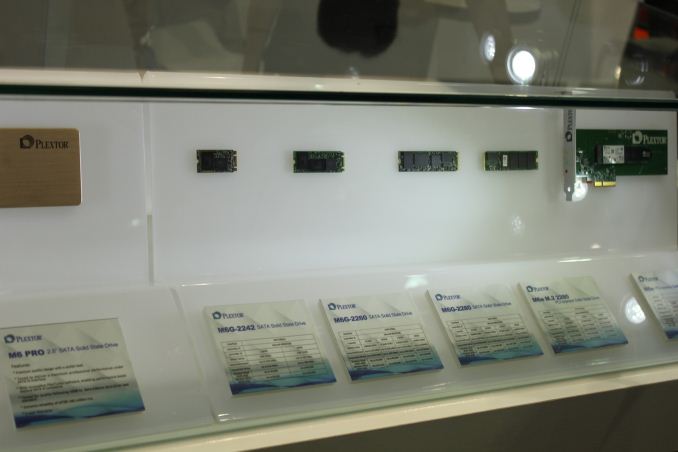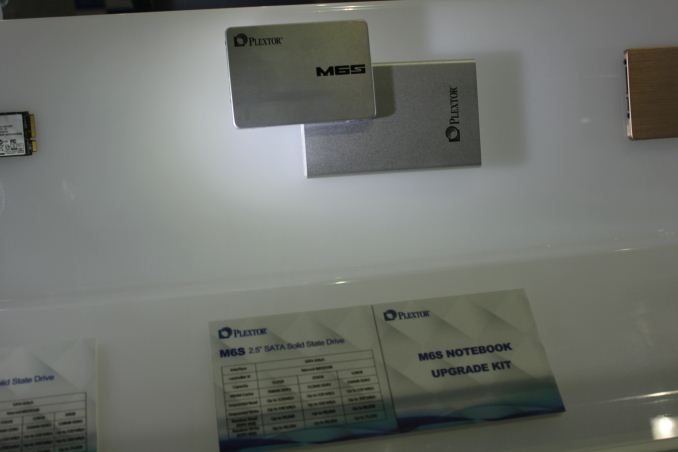Computex 2014: Plextor Announces M6 Pro SSD & PlexTurbo Software
by Kristian Vättö on June 8, 2014 9:57 AM EST- Posted in
- Storage
- SSDs
- Plextor
- Computex 2014
- M6 Pro

While Computex is already over for this year, we still have a lot of stuff to go through and post. I stopped by at Plextor's booth earlier this week and Plextor showed me their brand new M6 Pro along with PlexTurbo software. Plextor showed the M6 Pro already at CES this year but now the drive is nearly ready for the official release. The hardware inside hasn't changed from CES and it's still uses the Marvell 88SS9187 SATA 6Gbps controller with Toshiba's A19nm NAND and the release is scheduled to take place next month, so we should be able to get samples pretty soon.
In addition to just re-showing the CES products, Plextor also had something new to demo. PlexTurbo is software similar to Samsung's RAPID function and it leverages system RAM to increase transfer speeds. The key difference to RAPID is that PlexTurbo uses RAM as a write-through cache, which means that the data is written to both RAM and the SSD simultaneously. Samsung's approach is write-back based, which is more vulnerable to data loss as initially the data is only written to the cache and is not written to the SSD until the data in the cache is about to be modified. Both RAPID and PlexTurbo are limited to 1GB of RAM to ensure that the system still has enough RAM for standard operation.
Plextor showed me a video of their internal testing comparing PlexTurbo with RAPID in case the drive is disconnected right after writing something. In the test Plextor used a Word file that they modified and unplugged the drive after saving the file. With RAPID the modifications were lost, whereas thanks to Plextor's use of write-through cache the modifications remained intact. Of course this test was designed to promote PlexTurbo’s approach and we will have to run our own tests to confirm the results but it looks like Plextor’s approach might be a bit more reliable than Samsung’s.
PlexTurbo also appears to provide better performance as I saw speeds of up to 10GB/s when the settings were optimised for the software. Plextor did admit that the first generation of PlexTurbo was mostly designed for high benchmark scores, so I would take the results with a grain of salt, but the next version should focus more in actual real world performance. Either way, it’s certainly interesting to see how PlexTurbo stands up with RAPID. With SATA 6Gbps it’s getting very hard to differentiate in the market and providing software like PlexTurbo is one of the only ways, even though the real world gains are debatable.
Furthermore, Plextor announced an M.2 version of the M6e along with other SATA based M.2 SSDs. Currently the M6e has only been available with the half-height, half-length PCIe adapter, which is just added cost for users who are looking to upgrade the M.2 SSD in their laptops.
Plextor will also be bringing a notebook upgrade kit for the M6S. The kit includes a 2.5” chassis for the old internal drive, which can then be used as external storage for backups for instance. Finally, Plextor told me that they will be introducing M6V later this year. The V stands for value and this will be the budget drive from Plextor. I was’t able to get much details other than that it won’t use Toshiba NAND but this might as well be the TLC drive Plextor has been developing for years now.












8 Comments
View All Comments
Jeff7181 - Sunday, June 8, 2014 - link
"In the test Plextor used a Word file that they modified and unplugged the drive after saving the file. With RAPID the modifications were lost, whereas thanks to Plextor's use of write-through cache the modifications remained intact."Well, duh. That is the difference between write-back and write-through cache. Write-back sends an ack as soon as the write is committed in the cache. Write-through doesn't send an ack until the write is committed on the back end. The result is improved data integrity with write-through, but lower write performance. The opposite is true for write-back. One can't say that one approach is better than the other without defining a use case.
extide - Sunday, June 8, 2014 - link
It appears to be some sort of hybrid approach, because they are getting 5GB/sec write speeds in that benchmark screen shot. You would need write-back cache to get that fast of a write on a SATA6Gbit SSD. So it is a little bit confusing to me. Maybe they are flushing the buffer really fast, and if the buffer is <= 1GB it should be able to flush pretty fast.TheWrongChristian - Monday, June 9, 2014 - link
According to the RAPID white paper (http://www.samsung.com/pl/business-images/resource... RAPID makes the same cache write guarantees as the Windows built in cache, so is only write back until the point that a flush is issued. Applications should be flushing their files when saving them, so if Word in the demo is not flushing when saving, then that is the fault of Word, not RAPID caching. This seems more an indictment of Microsoft's Word.sheh - Sunday, June 8, 2014 - link
I fail to see why software caching is anything worth mentioning. This is the OS's job and it does it anyway. Maybe this or that 3rd party software can slightly improve performance in very specific cases, but anyway it has little to do with the hardware.Alexvrb - Sunday, June 8, 2014 - link
I doubt the OS does a whole ton of write caching on it's own. Either way I don't like solutions that have potential data integrity issues, but for mobile devices that have reliable battery power, either approach should be fine as long as the hardware/OS combination is stable.ShieTar - Sunday, June 8, 2014 - link
Windows definitly does a significant amount of write caching, and it warns you in its setting of the potential loss of data. Which mean, everybody who never had a problem with the normal Windows cache (enabled by default) should have no real problem with any other write-back implementation either.As far as slight improvements in specific cases go, AS-SSD is showing me at least very tangible improvements for random writes. And disabling the Windows cache really cripples the drive:
https://www.dropbox.com/s/8q4u75hndsdb5cl/Windows_...
I don't know how much of the difference is still there for a real-world scenario, and I don't know why the Samsung Implementation seems so much better OS one. Maybe the Windows cache is still optimized for HDDs.
Alexvrb - Sunday, June 8, 2014 - link
The built in write caching in Windows doesn't do nearly as much as RAPID and PlexTurbo. It's really night and day, otherwise Plextor and Samsung wouldn't have bothered. 1GB is a pretty big cache, for one thing. Their algorithms might be more aggressive too. That's why there's a large difference in scores vs the default caching.Anyway, the built in caching operates more like RAPID, because they're both write-back. So if you lose power or otherwise fail to shut down gracefully, you lose any data that hasn't been flushed yet. So yeah, if you have "never had a problem" that means you haven't had a system go down with a bunch of important data in the cache. So in that regard PlexTurbo is the best choice, being a write-through cache. Hard to say how it will compare in real-world performance compared to RAPID, however.
ShieTar - Monday, June 9, 2014 - link
I havn't had a sytem go down since I switched from Win98 to NT4.0, period. And I never experienced a power loss. And I assume my situation is rather typical for people in industrialised countries who don't challenge their system unusually, e.g who don't write low-level software or fill up their memory far beyond its capacity.I understand why write-through is the safer choice, but I think for the majority of computer users, including many professional users and enthusiast, the risk of a write-back is already extremely close to 0.
That being said, my personal preference would always be to offer both options to the user and let him make his own decision.